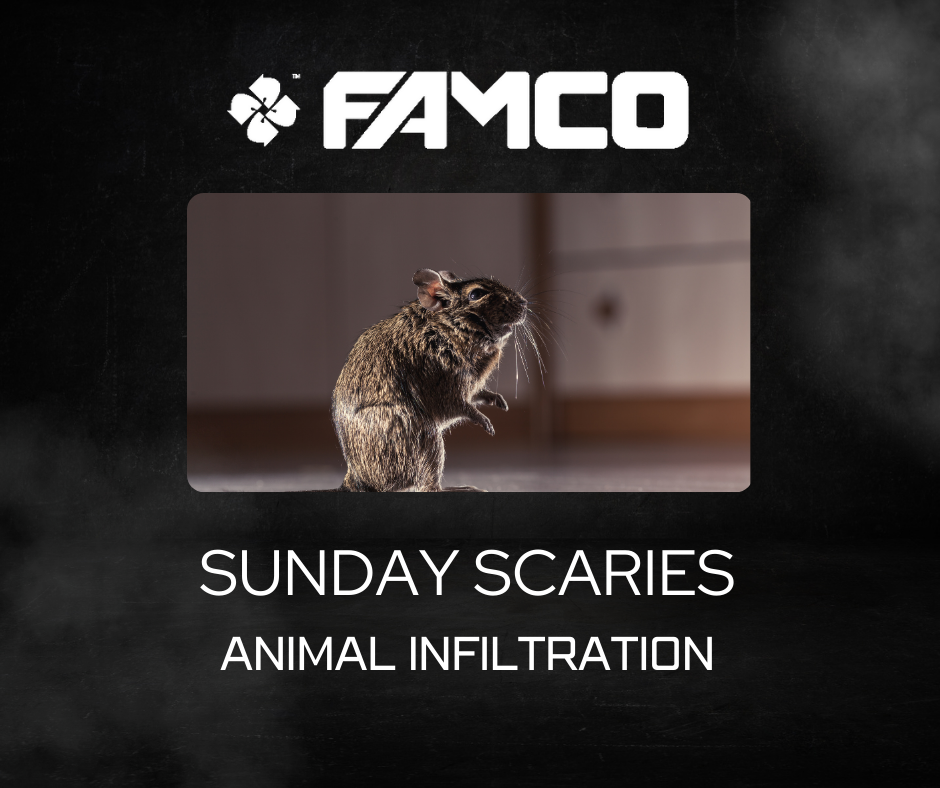Sunday Scaries: Animal Infiltration

One of the most common threats to a well operating HVAC system is animal infiltration. Unless you are a Disney princess, there is very little desire for rodents and birds to enter the comfort of your home. Having pests is nothing close to a fairytale, causing numerous problems such as degradation of HVAC system performance, odor accumulation, and fire threats. Knowing all the associated risks with animal infestation is important to implementing corrective action.
How Animals Enter the HVAC system:
In search of shelter and warmth, nesting animals will often pass through the home through roof vents, wall vents, and chimneys. This search for a new habitat can be a result of temperature drops for the animals to regulate or newcoming babies that need security from predators. Without protective equipment like screens, these rodents and birds can easily access the ductwork of the home for a comfortable living space. Their presence can create numerous problems if not properly exterminated.
Potential Damage and Threats Caused by Animals:
Several possibilities for damage are to be expected when an animal does infiltrate the duct system. One of which is the mutilation of flex ducts and fiberboard ductwork in your HVAC system. Animals often chew on these areas resulting in large openings and heavy debris all within the ductwork. This robs your HVAC system of its ability to perform efficiently. They can cause damage to your metal ductwork through manipulating it to bend and break to their needs. This inefficiency in the ductwork can lead to steep electrical and replacement bills if left undetected.
While in the ductwork of your home, these rodents and small animals tend to chew through the exposed wires in the HVAC system. This threat is often not detected until the HVAC system starts to function erratically or ceases to function at all. While it may interfere with HVAC efficiency, these exposed wires can also pose a danger to the occupants of your home. These animals strip the wire of its protective insulation, creating a potential fire hazard. If a live and exposed wire creates a spark with another metal material or exposed wire fire can easily spread throughout the home causing catastrophic damage.
The insulation in the HVAC system is also at risk from being used as nesting materials. Small creatures will use this foam material around copper and aluminum refrigerator lines to help create a habitual environment. Without this insulation, these refrigerator lines are susceptible to freezing temperatures creating more damage to the HVAC system. Debris of insulation material can also interfere with the HVAC system.
More problems can occur when the animal perishes while in the venting system. The decomposition of their body can create odors that extend throughout the HVAC system of the home. These pests can succumb to their injuries following combustion gases or the entrapment of these vents leading to their decaying. These odors also attract parasites, fleas, and various bacteria to the decomposing body inside the ductwork. When these pests block the exhaust ventilation of the home, combustion gases have a higher probability of flooding back into the home, increasing the risk of carbon monoxide poisoning.
Other smells can linger due to the animal droppings and urine that may get trapped inside the HVAC system. Animal urine is highly corrosive that can cause the ductwork to prematurely corrode while also fumigating the space. Urine and fecal matter can also negatively impact the evaporator and condenser coils of the HVAC system.
Removing and fixing any evidence of animal infiltration is essential for maintaining a functional HVAC system and a healthy home.
What To Do If You Suspect an Animal in Your Duct System:
If there is a suspicion that an animal has entered the HVAC system, follow these steps to remove the animal from the space.
If Dead:
1. Follow your nose, the odor from decomposition can help to locate the animal.
2. Prepare gloves and a bag: Never use your bare hands as the animal could carry bacteria and viruses.
3. Sanitize the area: Spray disinfectant everywhere the animal has been.
4. Remove the carcass or hire pest control to remove it.
If the animal is believed to be alive, call pest control to remove the animal.
Have a HVAC technician patch up any of the damage caused to the ductwork or the HVAC system. Make sure all cracks and gaps in the ductwork are sealed to prevent more pests from entering.
Products That Prevent Animal Infiltration:
For preventative measures, purchase vents with attached screens. FAMCO offers a variety of high-quality screens for roof and wall vent applications to ensure pests remain outside of the home. All FAMCO Hooded Wall Vents, Bathroom and Kitchen Exhaust Vents, Soffit Vents, and J vents include this optional attachment. Optional screen attachments are not limited to the metal product lines but are also available to our plastic ventilation products. The plastic Vent Guard is a protective barrier that attaches to the outside of the vent.
(Note that screens are not recommended for dryer applications as a potential fire hazard).
Leave housing animals up to the Disney Princesses. Have your happily ever after and say goodbye to animal infestation problems by checking out the FAMCO offering today!





